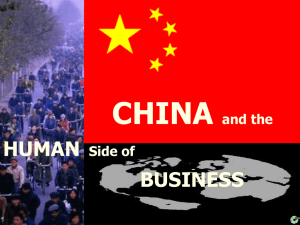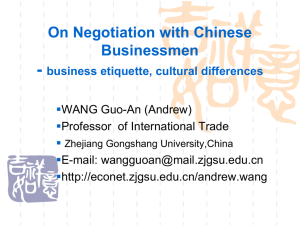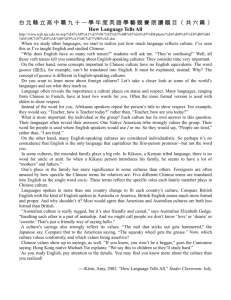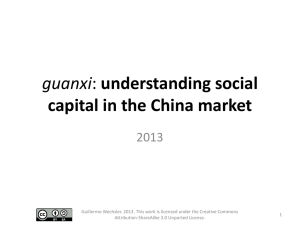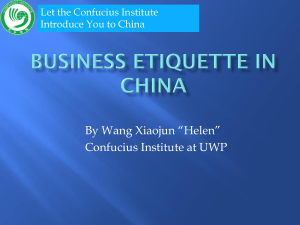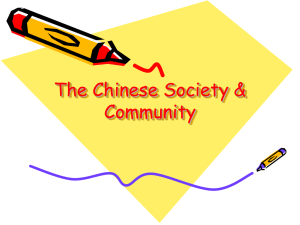Relationship marketing and its impact on the competitive structure
advertisement
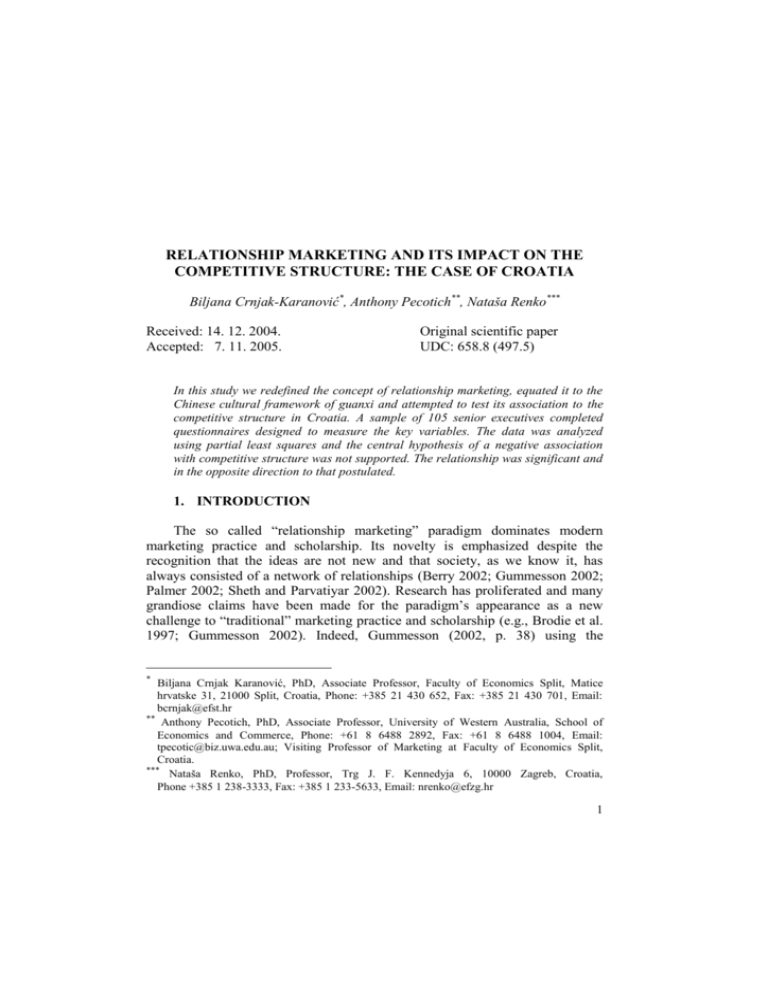
RELATIONSHIP MARKETING AND ITS IMPACT ON THE COMPETITIVE STRUCTURE: THE CASE OF CROATIA Biljana Crnjak-Karanović*, Anthony Pecotich**, Nataša Renko*** Received: 14. 12. 2004. Accepted: 7. 11. 2005. Original scientific paper UDC: 658.8 (497.5) In this study we redefined the concept of relationship marketing, equated it to the Chinese cultural framework of guanxi and attempted to test its association to the competitive structure in Croatia. A sample of 105 senior executives completed questionnaires designed to measure the key variables. The data was analyzed using partial least squares and the central hypothesis of a negative association with competitive structure was not supported. The relationship was significant and in the opposite direction to that postulated. 1. INTRODUCTION The so called “relationship marketing” paradigm dominates modern marketing practice and scholarship. Its novelty is emphasized despite the recognition that the ideas are not new and that society, as we know it, has always consisted of a network of relationships (Berry 2002; Gummesson 2002; Palmer 2002; Sheth and Parvatiyar 2002). Research has proliferated and many grandiose claims have been made for the paradigm’s appearance as a new challenge to “traditional” marketing practice and scholarship (e.g., Brodie et al. 1997; Gummesson 2002). Indeed, Gummesson (2002, p. 38) using the * Biljana Crnjak Karanović, PhD, Associate Professor, Faculty of Economics Split, Matice hrvatske 31, 21000 Split, Croatia, Phone: +385 21 430 652, Fax: +385 21 430 701, Email: bcrnjak@efst.hr ** Anthony Pecotich, PhD, Associate Professor, University of Western Australia, School of Economics and Commerce, Phone: +61 8 6488 2892, Fax: +61 8 6488 1004, Email: tpecotic@biz.uwa.edu.au; Visiting Professor of Marketing at Faculty of Economics Split, Croatia. *** Nataša Renko, PhD, Professor, Trg J. F. Kennedyja 6, 10000 Zagreb, Croatia, Phone +385 1 238-3333, Fax: +385 1 233-5633, Email: nrenko@efzg.hr 1 Management, Vol. 10, 2005, 2, pp. 1-20 B.Crnjak-Karanović, A. Pecotich, N. Renko: Relationship marketing and its impact on the... sociology of science arguments of Kuhn (1962) almost hints at a conspiracy to restrict the progress of this new “relationship marketing” paradigm as follows: As is characteristic of paradigm shifts, mainstream researchers, educators, and practitioners--who are in majority--attempt to force those who deviate from standard thinking--who are in minority—to adhere to the rules and regulations of ‘‘normal science’’ and to squeeze new thinking into the old costume. This resistance slows down and partly distorts the introduction of new marketing behavior. He states this, disregarding Popper’s (1959) arguments for scientific progress by critical destruction, and notwithstanding the evidence which suggests, for example, by the acknowledged proliferation of research, the use of the term in practice and even the existence of a journal of its own, that the paradigm has been, if anything, too readily and uncritically accepted in marketing (e.g., Berry 2002; Brodie et al. 1997; Gummesson 2002; Hunt, Lambe, and Wittmann 2002; Palmer 2002; Sheth and Parvatiyar 2002). Indeed the literature and the research is plagued by imprecision, definitional problems as recognized by Gummesson (2002, p. 39), the general poor specification of the nature of the paradigm and its philosophical implications for the economic functioning of industries or nations. Further, it appears that the psychological and sociological literature as well as the historical basis of trade in networks of human relationships most recently extensively emphasized in the examination of Chinese traditional values and labeled as Guanxi has been largely overlooked (e.g., Berscheid 1994; Ellis and Pecotich 2001a, 2002, 2001b; Lovett, Simmons, and Kali 1999; Pecotich and Chia 2002; Seung and Luo 2001; Xin and Pearce 1996; Zuobin 1999). It is our purpose to make a preliminary attempt to clarify some of these issues and on this basis to develop a conceptual structure to be tested in the applied marketing context of Croatia, and to present the results of such a test. 2. CONCEPTUAL DEVELOPMENT 2.1. Relationship marketing defined In the western (particularly the US and European) literature there has been a explosion of definitions of relationships marketing without clear agreement as to its nature and or the specification of its context or level of application (e.g., Grönroos 2000, 1997; Gummesson 2002; Morgan and Hunt 1994; Parvatiyar and Sheth 2000). The term has been used to describe relationships both at the individual and at the organizational level with terms such as: “affinity 2 Management, Vol. 10, 2005, 2, pp. 1-20 B.Crnjak-Karanović, A. Pecotich, N. Renko: Relationship marketing and its impact on the... marketing, loyalty marketing, cross selling, up selling, co-branding, comarketing, customer-supplier partnering, personalized one-to-one relationship key account management and solution selling” (Sheth and Parvatiyar 2002, p. 10), and there has been a failure to clearly separate, enumerate and integrate the two elements (i.e. relationships and marketing). Recently Gummesson (2002, p. 39; 1999, p. 24) has emphasized the long term nature of the relationship and taken a very broad view by referring to: Total relationship marketing is marketing based on relationships, networks and interaction, recognizing that marketing is embedded in the total management of the networks of the selling organization, the market and society. It is directed to long term win-win relationships with individual customers, and value is jointly created between the parties involved. It transcends the boundaries between specialist functions and disciplines. Total relationship marketing embraces not just the supplier-customer dyad as does one-to-one marketing and CRM (customer relationship management) but also relationships to a supplier’s own suppliers, to competitors and to middlemen; these are all market relationships. Sheth and Parvatiyar (2002, p. 10) elaborate further by suggesting that: (1) “it is a one-to-one relationship between the marketer and the customer (cannot exist at an aggregate level); (2) it is an interactive process and not a transaction exchange; and (3) it is a value-added activity through mutual interdependence and collaboration, between suppliers and customers. The picture is somewhat completed when one notes the emphasis on “mutual exchange and fulfillment of promises” by Grönroos, (1990, p. 7). Relationship marketing may therefore be viewed as a very broad type of relatively long term individual human business relationship involving a degree of collaboration and interdependence, which is based on the expectation of a fulfillment of promises in interactive marketing exchanges. It is noteworthy that this attempt at enumeration has not fully resolved the issues as the two key terms – marketing and relationships – still appear on both sides of the definitional equation and the equation is consequently tautological. It is, therefore, necessary to define both the key terms before proceeding further. Issues associated with the “nature and scope of marketing” have undergone extensive debate and have to a large extent been resolved (Hunt 1983, 1976a, 1976b) and it is not essential for us to revisit this matter but rather take it as given. The nature of relationships, however, is more central to the purposes of our study and needs to be enumerated. The American Heritage Dictionary (The American Heritage Dictionary of the English Language 1992) defines a 3 Management, Vol. 10, 2005, 2, pp. 1-20 B.Crnjak-Karanović, A. Pecotich, N. Renko: Relationship marketing and its impact on the... relationship as: (1) The condition or fact of being related - connection or association; (2) connection by blood or marriage, kinship; (3) A particular type of connection existing between people related to or having dealings with each other: has a close relationship with his sibling; and (4) A romantic or sexual involvement. There are, therefore, many kinds of relationships but they all involve a connection or association or to elaborate “a mental connection or relation between thoughts, feelings, ideas, or sensations - a remembered or imagined feeling, emotion, idea, or sensation linked to a person, object, or idea”(The American Heritage Dictionary of the English Language 1992). Our interpretation of this and the related psychological literature (Berscheid 1994) is that a degree of emotional commitment and intimacy is necessary, and that process and content issues are involved. In the relationship marketing context the strategic prescriptions essentially specify the processes necessary to establish the relationship the nature of which is the content. An interaction between persons can be conceptualized in terms of their needs, thoughts, and motives in relation to one another in the context of the specific social (marketing) situation in which their interaction transpires (Rusbult and Van Lange 2003, p. 352). Thus, a major purpose of relationship marketing is to establish corresponding interests that minimize information-seeking and that are unlikely to present moral dilemmas, but rather, through coordinating activities, ensure mutual beneficial outcomes. To rephrase, relationship marketing is a very broad type of relatively long term, voluntary, individual, human business association involving a degree of emotional commitment, trust, intimacy, collaboration and interdependence, which is based on the expectation of a reciprocal, fulfillment of promises in interactive marketing exchanges for mutual benefit. 2.2. Relationship marketing and Chinese, interpersonal connections guanxi Given this emphasis on relationship marketing in much of the western literature it is somewhat surprising that very little attention has been paid to the Chinese variant of the concept. Labeled simply as guanxi, it basically means a relationship. However, its implications are broad, complex and may be culture bound. The Chinese culture is deceptively varied and although built on a foundation of over 5,000 years it has undergone unmatched social and cultural transformation (Bond and Hwang 1986; Chan 1963a, 1963b; Chen 1973; Chen 2001; Cheng and Chan 2000; Wilson, Wilson, and Greenblatt 1979). Besides the historical transformations (e.g., wars and political changes) three influences have shaped the Chinese culture, as it exists at the beginning of this millennium: 4 Management, Vol. 10, 2005, 2, pp. 1-20 B.Crnjak-Karanović, A. Pecotich, N. Renko: Relationship marketing and its impact on the... the traditional values, Marxism and Mao’s philosophy, and the pragmatic approach of Deng (Pecotich and Yang 2001). The most enduring of these influences, and indeed the one that has been integrated into the Chinese psyche is the complex amalgam labeled “traditional Chinese values” (Pecotich and Chia 2002). The traditional values in turn have been shaped by Confucianist, Taoist, Buddhist and Feudalistic philosophies (Zheng 1997). It is these ancient sources that form the basis of personal associations referred to as a guanxi or networks of informal relationships and exchanges of favors that dominate business (Yang 1994; Zuobin 1999). The nature of these relationships, although postulated to have significant differences to western business practices, have surprising similarities to the notions advocated by the proponents of relationship marketing. Guanxi as practiced has both prescriptions for relationship formation and an understanding of the end result (content) of such relationships. For example, although our concern is with “content” the “process” prescription for network formation and expansion is to find an intermediary who introduces a newcomer to a stranger and who establishes the trustworthiness of the prospective partner (Lovett, Simmons, and Kali 1999). The relationship may be solidified by a skillful exchange of favors and gift giving. Similarly to relationship marketing this is not a simple exchange, transaction or barter but a long term “relationship in which the participants quickly begin to cement their ties through exchanges of respect and affection, as well as material objects or specific favors” (Lovett, Simmons, and Kali 1999, p. 233). Guanxi involves a subtle use of informal power within which a great emphasis is placed on face (mianzi). Although associated with Western terms like "prestige" or "reputation" it is a broader concept that can be defined as "the respectability and/or deference which a person can claim for himself from others" (Ho 1976, p.883) or simply "a positive public image" (Hsu 1996, p. 71). In China face is a social phenomenon which refers to two separate but related concepts: lian is the confidence of society in a person's moral character, while mianzi represents social perceptions of a person's personal prestige, reputation or esteem. As face translates into power and influence it is important to avoid its loss. For example, loss of lian would result in a loss of trust, while a loss of mianzi may result in a loss of authority (Lovett, Simmons, and Kali 1999). Given that the Chinese value orientation is directed at social harmony and work excellence respectively, conflict avoidance is a common cultural characteristic (Goffman 1955; Ho 1976; Hsu 1996). Face, therefore, is an important regulating force in social interactions. Guanxi members are connected through an unwritten code of reciprocity and equity. Renqing, a form of social capital, represents an informal expectation of reciprocity which if not met compromises the guanxi network. A 5 Management, Vol. 10, 2005, 2, pp. 1-20 B.Crnjak-Karanović, A. Pecotich, N. Renko: Relationship marketing and its impact on the... person who does not reciprocate is viewed as untrustworthy. Trust in turn is postulated to consist of three entities; integrity, benevolence, and ability (Mayer, Davis, and Schoorman 1995). All three must be present for a successful relationship. In attempting to establish East-West differences writers have disregarded the relationship marketing prescriptions, for example: (1) both are humanistic in their approach deemphasizing the impersonal and universalistic quality of the Protestant ethic; (2) rather than focusing on any particular transaction both are concerned with long-term pattern of behaviors grounded in ethical norms rather then the discrete-transaction paradigm based on classical western contract law; and (3) both believe that trust, commitment and loyalty and not a conflict oriented legal system will be the basis of the “new” economy (Gummesson 2002; Lovett, Simmons, and Kali 1999; Yang 1994; Yao 2000). So, to reiterate, while some tend to emphasize subtle differences using the inappropriate broad brush eastern-western dichotomy, the above discussion suggests that guanxi is also a very broad type of relatively long term, voluntary, individual, human business association involving a degree of emotional commitment, trust, intimacy, collaboration and interdependence, which is based on the expectation of a reciprocal, fulfillment of promises in interactive marketing exchanges for a mutual benefit. Hence, guanxi, an ancient system of relationship formation and management, may have universal application and is simply a variation of modern marketing prescriptions labeled as relationship marketing. It is our purpose to operationalise and test some propositions concerning this variable in the transforming and developing nation of Croatia. This nation has similarities to China in that it is developing and is moving to a market system. It also has a cultural history of operating through relationships. 2.3 The market system, competition, guanxi and relationship marketing Since the collapse of the Eastern block and the end of progressivism, the transforming and developing countries of the world have moved toward marketbased economies and the ideological debate between socialism and capitalism seems to have paused (Nee 1992, 1989; Pecotich, Renko, and Shultz 1994; Pecotich and Shultz 1998; Shultz and Pecotich 1997). Nonetheless, fundamental questions concerning the philosophical basis of the market system, competition and social justice remain (Chua 2003; Easterly 2001; Krugman 1997). With particular reference to this paper – in marketing we have the adoption of a “new” paradigm of relationship marketing (e.g. as far back as 1990 Heide and John have suggested that relationship marketing is a fait accompli (Heide and John 1990)) without any discussion or enumeration of its impact on the 6 Management, Vol. 10, 2005, 2, pp. 1-20 B.Crnjak-Karanović, A. Pecotich, N. Renko: Relationship marketing and its impact on the... competitively based market system. This is despite its growing importance as a western business practice and its position as a virtual clone of the dominant Chinese cultural business practice - guanxi. The advocates of relationship marketing and guanxi abound and arguments for their benefits are presented in terms of social and economic efficiency, and this “cooperative” approach is presented as superior to the “adversarial” market system (e. g. Berry 2002); Grönroos 1990, 2000, 1997; Gummesson 2002, 1999; Klein, Dansereau, and Hall 1994; Lovett, Simmons, and Kali 1999; Sheth and Parvatiyar 2002). Lovett, Simmons and Kali (1999, p. 243) in particular argue that “western businesses which are able to conduct transactions through trust-based agreements and long-term net-works of relationships will increasingly out compete those using traditional contracting methods.” The crux of their argument rests on the reduction of broadly defined transactions costs that are postulated to consist of “the opportunity costs resulting from the loss of flexibility” as well as “the legal costs of making and enforcing contracts.” Their position is conditional on the extent to which the new system is able to “rapidly accept new exchange partners on the basis of ability.” Their argument loses force when one notes that it is based on a future postulated change in the relationship structure, and in that they seem to disregard the long standing argument for the advantages of the market system and the basis of anti-trust (Porter 1985, 1980; Scherer 1980; Von Mises 1963). Whatever the future may hold, as Lovett, Simmons and Kali (1999, p. 243) later recognize, the present emphasis is on loyalty and “(t)he result is that talented individuals are either suffocated or squeezed out of the business and that the business itself is unable to achieve growth or diversification.” One does not have to take an extreme position to recognize the possibility that relationship marketing and or guanxi may be anti-competition and corruptive of the market system. The market is a process, actuated by the interplay of the actions of the various individuals. It involves cooperation in the sense that there is acceptance as to how the system is to operate, but this can not be collusion that subverts the market (e.g., Lane 1991; Lindblom 2001, 1977; Porter 1985, 1980; Scherer 1980; Von Mises 1963). The market is postulated to be free and prices are set through a competitive interplay without interference from institutional forces. The market determines the nature of production as well as the price and quantity of what is produced. According to Von Mises (1963, p. 274), “(i)n the market economy, competition manifests itself in the fact that the sellers must outdo one another by offering better or cheaper goods and services, and that the buyers must outdo one another by offering higher prices. It means the opportunity to serve the consumers in a better or cheaper way without being restrained by privileges granted to those whose vested 7 Management, Vol. 10, 2005, 2, pp. 1-20 B.Crnjak-Karanović, A. Pecotich, N. Renko: Relationship marketing and its impact on the... interests the innovation hurts.” Workable competition is therefore, a vital component of the market system leading to greater efficiency and human welfare. At the layman level it may be described “as the action of endeavoring to gain what another endeavors to gain at the same time.” More formally Hunt (2000, p., 135) has defined it as “the constant struggle among firms for comparative advantage in resources that will yield marketplace positions of competitive advantage for some market segments and, thereby, superior financial performance.” It seems that competition is a kind of behavior involving “structure” (the environment in which the firm must compete) and processes. It involves the conditions prevailing in the market in which rival sellers try to increase their profits at one another's expense. In the economic sense it may range from perfect competition in which numerous firms produce or sell identical goods or services to oligopoly in which a few large sellers with substantial influence on the market compete for business (Hunt 2000). Although the market system may well be an unreachable ideal it is clear that it is a goal aimed at by U.S. antitrust laws as well as the philosophical basis of the reforms in much of the transforming and developing world (e.g., Dollar and HallwardDriemeier 2000; Koves and Marer 1991; Lane 1991; Lindblom 2001; Lovett, Simmons, and Kali 1999; Pecotich and Shultz 1998). The advocates of relationship marketing and guanxi appear to have overlooked the possibility that their prescriptions may be interpreted as antimarket and destructive of competition. The building of long term relationships, as defined above and almost in any form as described in the literature, changes the marketing game to a more complex form. In this form the critical strategic competitive forces (such as price and quality) are subverted by the quality of a personal relationship to the extent that it is the manifest intention of practitioners of relationship marketing (or guanxi) to grant and gain privileges from a deliberately developed relationship whose purpose is to restrict competitive action (e.g., freedom of entry and exit or information) and protect both parties from more efficient competitors and the economic system is damaged. Indeed it is not a far step to suggest that the whole purpose of relationship marketing is to subvert the market system and to injure competition by reverting to an ancient system of crony capitalism. The possibility of this becomes clear when one notes that, for example, a contract may be granted to a supplier within the relationship network rather than to a low bidder all other things being equal. This violates the structure of the market system and is readily seen as a violation of the principle of "fairness" or "equal opportunity" and is injurious to competition. 8 Management, Vol. 10, 2005, 2, pp. 1-20 B.Crnjak-Karanović, A. Pecotich, N. Renko: Relationship marketing and its impact on the... Further, recognizing that the line may in some cases be thin, a marketing system that is based on an a mutual exchange of relationship enhancing benefits (gifts in the guanxi case) may be construed as bribery despite the ethical basis of guanxi in Confucianism (Yang 1994). It is asserted by some that bribery is plainly an illicit action while relationship marketing and guanxi are concerned with relationship building, and that this is not bribery because the gain-and-loss calculation does not dominate and the obligation is long-term and diffuse. Bribery, however, is for an immediate and specific purpose, and some level of emotional content or affect is a part of guanxi, but not necessarily of bribery (Chan 1963a, 1963b; Lovett et al. 1999; Yang 1994; Yao 2000). Nonetheless, until the definition and paradigmatic issues are clarified as well as the nature of marketing practice, it is a distinct possibility that ethical problems abound and that the fundamental effect of relationship marketing is to reduce competition as formulated in marketing and economics (Cravens, Hills, and Woodruff 1980; Grewal and Tansuhay 2001; Hunt 2000; Porter 1980; Scherer 1980). Following the recommendations of Xin and Pearce (1996, p. 1995) that future research should address questions associated with the effects of guanxi in other settings, it is our purpose to report the findings of an empirical study designed to test this proposition in the Croatian context. This is a developing, transforming nation that is undergoing massive economic upheaval, and which in some respects has similarities with China i.e. it is emerging from a state controlled economic system and moving to a market system, it has a strong cultural basis where patronage and relationships have dominated, and it has opened up to western business education to an unprecedented extent (e.g.,Pecotich and Chia 2002; Pecotich, Renko, and Shultz 1994; Pecotich and Yang 2001; Yuliang 1997). 3. METHOD 3.1. Sample The sample composed of 105 senior managers who were involved in corporate strategic decision making. They were employed in various industries from state-owned (18.1%), state/private-hybrid (5.7%), and private companies (76.2%) in competitive industrial environments throughout Croatia. Due to Croatia's recent turbulent history, it was difficult to find executives willing to readily share business information by using a direct or mail approach. To overcome this problem, attendees of an executive development program were approached and possible participants were identified on the basis of this. A drop-off and pick-up procedure was used to collect the data from key 9 Management, Vol. 10, 2005, 2, pp. 1-20 B.Crnjak-Karanović, A. Pecotich, N. Renko: Relationship marketing and its impact on the... informants. With the key informant approach, data is collected from a senior manager or a group of senior managers on information pertaining to the whole organization (or business unit). It is assumed that such senior managers have the best vantage point for viewing the entire organization and, thus, will provide the most accurate responses. Instructions were developed to ensure that the respondents understood the purpose of the study, the assurance of confidentiality and that they were able to provide answers only in relation to the particular business unit involved and their most important business relationship. Of 129 questionnaires distributed 105 were returned giving a response rate of 80 per cent which was considered satisfactory given previous experience with surveys of a similar nature (Dillman 2000; Dillman et al. 1974; Groves 1989; Kotha, Rajgopal, and Rindova 2001; Wold 1981). The sample emanated from a wide variety of industries (16 per cent were involved with consumer products, 19 per cent with industrial products, and 65 per cent with services), and relationships (8 per cent were government officials or politicians, 30 per cent were customers, 26 per cent suppliers, 32 per cent service partner and 5 per cent were distributors) thus, representation was considered adequate. 3.2. Procedures and Measures The data was collected using a self-administered questionnaire that was partially adapted from existing instruments and partially developed for the purposes of this study in English. The instrument was translated into Croatian and back-translated into English to ensure accuracy of translation and pre-tested with 11 potential respondents as recommended by Brislin (1986). The respondents were asked to complete a set of items in relation to their “major business partner” on scales ranging from 0 (completely inaccurate) to 6 (completely accurate) indicating the extent to which the statement accurately described the nature of that relationship. In operationalizing relationship marketing (or guanxi) it was necessary to reexamine our definition and develop the instrument with careful reference to its components. For convenience of reference the definition is restated: it is also a very broad type of relatively long term, voluntary, individual, human business association involving a degree of emotional commitment, trust, intimacy, collaboration and interdependence, which is based on the expectation of a reciprocal, fulfillment of promises in interactive marketing exchanges for a mutual benefit. The first element of the definition concerned the “relatively long term nature” of the relationship. This was measured using four items emphasizing the long term nature of the relationship (e.g. “I share long-term goals with this partner”) adapted from Mak (2003). Following the recommendations of Nunally 10 Management, Vol. 10, 2005, 2, pp. 1-20 B.Crnjak-Karanović, A. Pecotich, N. Renko: Relationship marketing and its impact on the... and Bernstein (1994) the data was factor analyzed to check the dimensionality and coefficient alpha was computed to evaluate the internal consistency. In this case, the instrument was found to be unidimensional and the index of reliability was found to be a satisfactory .78. The second relevant element the extent of the “voluntary” nature of the relationship was measured by eight items (e.g. “This is a voluntary relationship where we can define our own roles”) and was found to have satisfactory dimensionality and reliability (.75). Similar results were obtained for “individual, human business association” which was measured by five items (e.g. “This partnership is based on “human feelings” of respect and caring for important others”) with an alpha of .77. “Emotional commitment” was a six item measure (e.g. “The relationship with this partner is something that we are very committed to”) adapted form Morgan and Hunt (1994) which was found to have an alpha of .83. The “trust” instrument was also adapted from Morgan and Hunt (1994) (e.g. “This partner has high integrity”) with items involving ability, and benevolence added. The twelve item scale was found to have excellent properties with a reliability of .90. “Intimacy” was adapted from Mak (2003) and the three item measure (e.g., “My partner and I have much in common beyond work obligations”) was found to be satisfactory (alpha .70). The measure for “collaboration” was similarly developed and the three item measure (e.g., “We work on our problems together”) was found to have a relatively high alpha of .84. “Interdependence” was measured by ten items (e.g. “I can depend on favors from my business partner”) and was found to be satisfactory (alpha .76). “Reciprocity” was a fourteen item measure (e.g., “In essence this relationship is based on the principle of reciprocity”) also adapted from Mak (2003) which was found to be satisfactory (alpha .89). The “mutual benefit” component was measured by six items (e.g., “In forming this relationship I had to find out if the person is amenable to granting aid in return for gifts, and what s/he would most appreciate in a gift”) and also found satisfactory (alpha .71). Finally the measure of the extent of competition was measured using the rivalry component of “Industruct” a scale for the measurement of perceptions of industry structure developed by Pecotich, Hattie and Low (1999). This was an eight item measure which was found to have an alpha of .85 and therefore in this context found to be satisfactory. To summarize, the data suggests that at this preliminary stage the measures were satisfactory, none of the reliability indices were below .7 and some were as high as .9 (Nunnally and Bernstein 1994). 11 Management, Vol. 10, 2005, 2, pp. 1-20 B.Crnjak-Karanović, A. Pecotich, N. Renko: Relationship marketing and its impact on the... 4. ANALYSES AND RESULTS Prior to beginning more complex analyses, the descriptive statistics for the summated scales for each of the measures were examined and are shown in Table 1. As can be seen, the means on the seven point scale (0 to 6) are uniformly around the midpoint or below with the exception of collaboration (mean = 4.25). This suggests that, in absolute terms, the levels of both relationship marketing and competition may be low although this may be too strong a statement until norms are established, and further studies in different settings are completed, which will allow stronger comparative conclusions. Table 1. - Descriptive Statistics for the Measures N Mean Std. Deviation Long term Voluntary Individual Emotion Trust Intimacy Collaboration Interdependent Mutual benefit Reciprocity 105 105 105 105 105 105 105 105 105 105 3.85 2.83 2.79 3.84 3.74 2.16 4.25 3.01 2.66 2.67 0.80 1.02 1.25 1.05 1.08 1.44 1.34 0.94 1.09 1.16 Competition 105 3.21 1.29 Nature of Relationship To test our main theoretical proposition of a negative association, it was decided to use the partial least squares (PLS) estimation procedure (Chin 1998; Fornell and Cha 1994; Lohmoeller 1989; Wold 1981). PLS is a general technique for estimating path models involving latent constructs indirectly observed by multiple indicators. It was developed by Wold (1981) to avoid the necessity of large sample sizes and ‘hard’ assumptions of normality. It was, therefore, considered particular appropriate in this study as the sample size is small and our aims are largely exploratory. A PLS model is formally specified by two sets of linear relations: the outer model in which are specified the relationships between the latent and the manifest variables; and the inner model where the hypothesized relationships between the latent variables are specified and whose interpretation is as for standardized regression coefficients. We 12 Management, Vol. 10, 2005, 2, pp. 1-20 B.Crnjak-Karanović, A. Pecotich, N. Renko: Relationship marketing and its impact on the... formulated the relationship (guanxi) measures as reflective indicators in which case the classic test theory factor analytic model applies (see Figure 1). The revised PLS computer program (Chin and Fry 2003) was used to systematically evaluate the properties of the outer and the inner model as formulated in Figure 1. The evaluation of complex models cannot be made on the basis of any single general fit index but rather involves a systematic examination of a number of fit indices to establish the predictive relevance of the (Lohmoeller 1989). The results in relation to the outer measurement model are shown on the left side of Figure 1. For the latent variable relationship marketing the bootstrap critical ratios (Chin 1998) are acceptable (greater than 1.96) for all variables, the Average Variance Extracted (AVE) (Chin 1998; Fornell and Cha 1994) was a relatively high .43 and the combined reliability was a very satisfactory .88. The postulated negative association between relationship marketing and competition was not supported (Figure 1) - the standardized regression coefficient was significant but in the opposite direction ( = .32, p < .05). The mean proportion of variance explained (AVA) in this case the R2 for the endogenous variables was 0.10 equal to the recommended minimum. 5. DISCUSSION AND CONCLUSION The purpose of this study was to link the largely western concept of relationship marketing to the similar Chinese cultural framework guanxi and to evaluate the impact of these ideas on the competitive structure within a developing, transforming nation. Basing our arguments on classic economic formulations of the market system, and the possibilities of crony capitalism, corruption and bribery, we postulated a negative relationship between the existence of relationship marketing (guanxi) and the extent of competition. We tested this proposition using the responses to a self administered questionnaires from 105 Croatian executives. It was asserted that this developing, transforming nation that is emerging from a state controlled economic system and moving to a market system was particularly suitable for such a test. While the measurement properties of the instruments were found to be satisfactory, the central hypothesis was not supported. Indeed the relationship was found to be significant but in the opposite direction so that the data suggested that the greater the use of relationship marketing techniques, the greater the competition in the market place. These, exploratory findings, therefore appear to refute our arguments concerning the market system and corruption but appear to support those advocating relationship marketing (guanxi) as a legitimate source of competitive advantage which increases market turbulence; and may lead to 13 14 Mutual benefit Reciprocity Interdepandent Collaboration Intimacy Trust Emotion Individual Voluntary Long term Relationship Marketing - (.32) R2 = .10 Competition signif icant at p< .05. 2 R 2 indicates the proportion of v ariance explained by the relev ant regression equation. Note: 1 The + or - indicate the direction of the postulated relationship and the f igures in parentheses are f actor loadins or regression coef f icients all of which were + (.75) + (.60) + (.69) + (.43) + (.58) + (.61) + (.67) + (.78) + (.74) + (.65) Figure 1 The Relationship Marketing (Guanxi) and Competition Management, Vol. 10, 2005, 2, pp. 1-20 B.Crnjak-Karanović, A. Pecotich, N. Renko: Relationship marketing and its impact on the... Figure 1 – The Relationship Marketing (Guanxi) and Competition Note: 1The + or – indicate the direction of the postulated relationship and the figures and the figures in parentheses are factor loadings or regression coefficients all of which are significant at p< .05 2 2 R indicates the proportion of variance explained by the relevant regression equation Management, Vol. 10, 2005, 2, pp. 1-20 B.Crnjak-Karanović, A. Pecotich, N. Renko: Relationship marketing and its impact on the... benefits from economic efficiency and broadly defined lower transactions costs In conclusion, we must caution against unconditional acceptance of the results of this study. While advocates of relationship marketing and guanxi may take comfort from these findings it should be noted that this is a single study using a small sample whose findings can only be considered preliminary. As with all research, the study has many limitations whose deficiencies can only be corrected by further research in different contexts with varying methodologies. We have challenged a major marketing dogma in a nation undergoing economic restructuring with imperfect measures and methods. It is our hope that future research will be rise to this challenge and address this critical issue with new conceptual structures and more fully developed instrumentation. REFERENCES: 1. The American Heritage Dictionary of the English Language, (3rd Ed.), Houghton Mifflin Company, Boston, 1992. 2. Berry, Leonard L. "Relationship Marketing of Services - Perspectives from 1983 and 2000," Journal of Relationship Marketing, 1 (1), 59-78, 2002. 3. Berscheid, Ellen. "Interpersonal relationships," Annual Review of Psychology, 45, 79-129, 1994. 4. Bond, M. H. and K.K. Hwang. "The social psychology of Chinese people," in the psychology of the Chinese people, M. Bond, Ed. Oxford University Press, Hong Kong, 1986. 5. Brislin, R. W. "The wording and translation of research instruments," in Field methods in cross-cultural research, W. J. Lonner and J. W. Berry, Eds. Sage, Beverly Hills CA, 1986. 6. Brodie, Roderick J., Nicole E. Covielo, Richard W. Brooks, and Victoria Little. "Towards a Paradigm Shift in Marketing? An Examination of Current Marketing Practices," Journal of Marketing Management, 13, 383406, 1997. 7. Chan, W. T. (1963a), Source Book in Chinese Philosophy, University of Hawaii Press, Princeton, N.J.,1963. 8. *** (1963b), The Way of Lao Tzu (Tao Te Ching, Bobbs-Merrill, New York, 1963. 9. Chen, T.S. 1001 Chinese sayings (in Chinese), The Chinese University of Hong Kong, Hong Kong, 1973. 10. Chen, Y. "Chinese values, health and nursing," Journal of Advanced Nursing, 36 (2), 270-73, 2001. 11. Cheng, H. and K. Chan. "One Country, Two Systems: Cultural Values Reflected in Chinese and Hong Kong Television Commercials," 15 Management, Vol. 10, 2005, 2, pp. 1-20 B.Crnjak-Karanović, A. Pecotich, N. Renko: Relationship marketing and its impact on the... 12. 13. 14. 15. 16. 17. 18. 19. 20. 21. 22. 23. 24. 25. 16 Proceedings of the Conference of the American Academy of Advertising, 134, 2000. Chin, W. and T.A. Fry. PLS-Graph 3.0 build 1017, Soft modeling Inc, Houston, 2003. Chin, W. W. "The partial least squares approach for structural equation modeling," in Modern methods for business research, G. A. Marcoulides, Ed., Lawrence Erlbaum Associates, CA, 1998. Chua, Amy. World on Fire: How Exporting Free Market Democracy Breeds Ethnic Hatred and Global Instability, Doubleday, NY, 1998. Cravens, D. W., G. E. Hills, and R. B. Woodruff. Marketing Decision Making: Concepts and Strategy (Rev Ed.), Richard D. Irwin, Homewood, 1980. Dillman, Don A. Mail and Internet Surveys, John Wiley & Sons, New York, 2000. Dillman, Don A., James A. Christensen, Edwin H. Carpenter, and Ralph Brooks. "Increasing Mail Questionnaire Response, A Four State Comparison," American Sociological Review, 39 (October), 1974. Dollar, D. and M. Hallward-Driemeier. "Crisis, Adjustment, and Reform in Thailand's Industrial Firms," The World Bank Research Observer, 15 (1), 122, 2000. Easterly, William. The Elusive Quest for Growth: Ecomomists' Adventures and Misadventures in the Tropics, MIT Press, Cambridge, 2001. Ellis, Paul and Anthony Pecotich (2001a), "Finding International Exchange Partners: The Role of Social Ties," Global Focus, 13 (2), 121-33, 2001. *** (2002), "Macromarketing and International Trade: Comparative Advantage versus Cosmopolitan Considerations," Journal of Macromarketing, 22 (1), 32-56, 2002. *** (2001b), "Social Factors Influencing Export Initiation in Small and Medium-Sized Enterprises," Journal of Marketing Research, XXXVIII, (1), 119-30, 2001. Fornell, C and J. Cha. "Partial Least Squares," in R.P. Bagozzi, (Ed.), Advanced Methods of Marketing Research, Basil Blackwell Ltd, Oxford, 1994. Goffman, Erving. "On face work. An analysis of ritual elements in social interaction," Psychiatry (18), 213-31, 1955. Grewal, Rajdeep and Patriya Tansuhay. "Building Organizational Capabilities for Managing Economic Crisis: The Role of Market Orientation and Strategic Flexibility," The Journal of Marketing, 65 (April 2001), 67-80, 2001. Management, Vol. 10, 2005, 2, pp. 1-20 B.Crnjak-Karanović, A. Pecotich, N. Renko: Relationship marketing and its impact on the... 26. Grönroos, Christian. "Relationship Approach to Marketing in Services Contexts: The Marketing and Organizational Behaviour Interface," Journal of Business Research, 20, 3-11, 1990. 27. *** (2000), Service Management and Marketing, Chichester, Wiley, 2000. 28. *** (1997), "Value-driven Relationship Marketing: From Products to Resources to Values," Journal of Marketing Management, 13 (5), 407-20, 1997. 29. Groves, Robert M. Survey Errors and Survey Costs, John Wiley & Sons, New York, 1989. 30. Gummesson, Evert. "Relationship Marketing in the New Economy," Journal of Relationship Marketing, 1 (1), 37-58, 2002. 31. *** (1999), Total Relationship Marketing, Butterworth Heinemann, Oxford, 1999. 32. Heide, Jan B. and George John. "Alliances in Industrial Purchasing: The Determinants of Joint Action in Buyer-Supplier Relationships," Journal of Marketing Research, XXVII (February), 24-36, 1990. 33. Ho, D. Y. F. "On the Concept of Face," American Journal of Sociology, 81 (4), 867-84, 1976. 34. Hsu, Chuansi Stephen. "Face", An Ethnographic Study of Chinese Social Behavior, Ann Arbor, UMI, 1996. 35. Hunt, Shelby D. "General Theories and the Fundamental Explananda of Marketing," Journal of Marketing, 47 (Fall), 9-17, 1983. 36. *** (2000), A General Theory of Competition: Resources, Competencies, Productivity, Economic Growth, Sage Publications, Inc, Thousand Oaks, 2000. 37. *** (1976a), Marketing Theory: Conceptual Foundations of Research in Marketing, Grid Inc, Columbus, 1976. 38. *** (1976b), "The Nature and Scope of Marketing," Journal of Marketing, 40 (July), 17-28, 1976. 39. Hunt, Shelby D., C. Jay Lambe, and C. Michael Wittmann. "A Theory and Model of Business Alliance Success," Journal of Relationship Marketing, 1 (1), 17-36, 2002. 40. Klein, J. Katherine, Fred Dansereau, and Rosalie J. Hall. "Levels Issues in Theory Development, Data Collection and Analysis," Academy of Management Review, 19 (2), 195-229, 1994. 41. Kotha, S., S. Rajgopal, and V. Rindova. "Reputation Building and Performance: An Empirical Analysis of the Top-50 Pure Internet Firms," European Management Journal, 19 (6), 571-86(16), 2001. 42. Koves, Andras and Paul Marer. "Economic Liberalization in Eastern Europe and in Market Economies," in Foreign Economic Liberalization: 17 Management, Vol. 10, 2005, 2, pp. 1-20 B.Crnjak-Karanović, A. Pecotich, N. Renko: Relationship marketing and its impact on the... 43. 44. 45. 46. 47. 48. 49. 50. 51. 52. 53. 54. 55. 56. 57. 58. 18 Transformations in Socialist and Market Economies, Andras Koves and Paul Marer, Eds. Boulder, Westview Press, 1991. Krugman, P. "Whatever happened to the Asian Miracle?," Vol. 2002, 1997. Kuhn, T. The Structure of Scientific Revolutions, University of Chicago Press, Chicago, 1962. Lane, Robert. The Market Experience, Cambridge University Press, Cambridge, 1991. Lindblom, Charles E. The Market System, Yale University Press, New Haven, 2001. *** (1977), Politics and Markets. Basic Books, N.Y., 1997. Lohmoeller, J.B. Latent variable modelling with Partial Least Square, Heidelberg, Physica-Verlag, 1989. Lovett, Steve, Lee C Simmons, and Raja Kali. "Guanxi versus the market: Ethics and efficiency," Journal of International Business Studies, 30 (2), 231-47, 1999. Mak, Kenneth. "Relational Components of "Guanxi": Embedded Societal Relations with Economic Transactions. A Socio-Psychological Perspective for Relationship Marketing," Unpublished Honours Thesis, University of Western Australia, 2003. Mayer, Roger C., James H. Davis, and David F. Schoorman. "An integrative model of organizational trust," The Academy of Management Review, 20 (3), 1995. Morgan, Robert M. and Shelby D. Hunt. "The Commitment Trust Theory of Relationship Marketing," Journal of Marketing, 58 (July), 20-38, 1994. Nee, V. "Organizational dynamics of market transition: Hybrid firms, property rights, and mixed economy in China," Administrative Science Quarterly, 31, 1-27, 1992. *** (1989), "A theory of market transition: From redistribution to markets in state socialism," American Sociological Review, 54 (663-681), 1989. Nunnally, J. C. and Ira H. Bernstein. Psychometric Theory (3rd Ed.), McGraw-Hill Book Inc, New York, 1994. Palmer, Adrian. "The Evolution of an Idea: An Environmental Explanation of Relationship Marketing," Journal of Relationship Marketing, 1 (1), 7997, 2002. Parvatiyar, Atul and Jagdish N. Sheth. "The Domain and Conceptual Foundations of Relationship Marketing," in Handbook of Relationship Marketing, Jagdish N. Sheth and Atul Parvatiyar, (Eds.), CA, Sage Publications, Thousand Oaks, 2000. Pecotich, A., J. Hattie, and Li Peng Low. "Development of Industruct: A Scale for the Measurement of Perceptions of Industry Structure," Marketing Letters, 10 (4), 409-22, 1999. Management, Vol. 10, 2005, 2, pp. 1-20 B.Crnjak-Karanović, A. Pecotich, N. Renko: Relationship marketing and its impact on the... 59. Pecotich, Anthony and Hock Hwa Chia. "Macromarketing and Traditional Chinese Wisdom for Modern Business," in Macromarketing in the Asia Pacific Century, The Proceedings of the 27th Annual Macromarkeiting Conference, Jack Cadeaux and Anthony Pecotich (Eds.), the University of New South Wales, Sydney, 2002. 60. Pecotich, Anthony and C. Shultz Eds. Marketing and Consumer Behaviour in East and South-East Asia, McGraw-Hill Book Company Pty. Ltd, Sydney, 1998. 61. Pecotich, Anthony and Song Yang. "Traditional Chinese Culture and Socialist Ideology in Personal Selling: an Exploratory Evaluation," in Bridging Marketing Theory and Practice, Proceedings of the Australian and New Zealand Marketing Academy Conference, Sylvie Chetty and Brett Collins (Eds.), College of Business, Massey University, Albany, New Zealand, 2001. 62. Popper, K. R. The Logic of Scientific Discovery, NY, Basic Books, New York, 1959. 63. Porter, Michael E. Competitive Advantage, The Free Press, New York, 1985. 64. *** (1980), Competitive Strategy: Techniques for Analyzing Industries and Competitors, The Free Press, New York, 1980. 65. Rusbult, Caryl E. and Paul A. M. Van Lange. "Interdependence, Interaction, and Relationships," Annual Review Psychology, 54, 351-75, 2003. 66. Scherer, F. M. Industrial Market Structure and Economic Performance, Rand McNally College Publishing Company, Chicago, 1980. 67. Seung, Ho Park and Yadong Luo. "Guanxi and Organizational Dynamics: Organizational Networking in Chinese Firms," Strategic Management Journal, 22, 455–77, 2001. 68. Sheth, Jagdish N. and Atul Parvatiyar. "Evolving Relationship Marketing into a Discipline," Journal of Relationship Marketing, 1 (1), 3-36, 2002. 69. Shultz, C. J. I. and A. Pecotich. "Marketing and Development in the Transition Economies of Southeast Asia: Policy Explication Assessment and Implications," Journal of Public Policy and Marketing, 16 (1), 55-68, 1997. 70. Von Mises, Ludwig. Human Action: A Treatise on Economics (4th Rev. Ed.), Fox & Wilkes, San Francisco, 1963. 71. Wilson, Richard W., Amy Aurebacher Wilson, and Sidney L. Greenblatt Eds. Value Change in Chinese Society, Praeger Publishers, New York, 1979. 72. Wold, H. "Model construction and evaluation when theoretical knowledge is scarce: theory and application of partial least squares," in Evaluation of 19 Management, Vol. 10, 2005, 2, pp. 1-20 B.Crnjak-Karanović, A. Pecotich, N. Renko: Relationship marketing and its impact on the... 73. 74. 75. 76. 77. 78. Econometric Models, J. Kmenta and J. Ramsey, (Eds.), Academic Press, New York, 1981. Xin, Katherine R and Jone L Pearce. "Guanxi: Connections as substitutes for formal institutional support," Academy of Management Journal, 39 (6), 1641-58, 1996. Yang, M. M. Gifts, favors and banquets: The art of social relationships in China, Cornell University Press, Ithaca, NY, 1994. Yao, X. An Introduction to Confucianism, Cambridge University Press, Cambridge, 2000. Yuliang, W. "On the Basic Characteristics of Deng Xiaoping's Values," Jen wen tsa chih (3p107), 1, 1997. Zheng, Yishan Ed. The compilation of three religions: Confucianism, Taoism and Buddhism (in Chinese), Zheng Yishan Press, Taibei, Taiwan, 1997. Zuobin, S. The Evolution of Values of Contemporary Chinese Social Development and Its Causes," She hui ko hsueh chi kan (1), 28, 1999. MARKETING ODNOSA I NJEGOV UTJECAJ NA KONKURENTSKU STRUKTURU: SLUČAJ HRVATSKE Sažetak U ovom radu, autori su redefinirali koncept marketinga odnosa i usporedili ga s kineskim konceptom guanxi kulture, te pokušali testirati njegovu povezanost s konkurentskom strukturom u Hrvatskoj. Na uzorku od 105 managera najviše razine, provedeno je anketno istraživanje uz pomoć kojeg su izmjerene vrijednosti ključnih varijabli. Dobiveni su se podaci analizirali metodom najmanjih parcijalnih kvadrata, pri čemu nije potvrđena temeljna hipoteza o negativnoj povezanosti marketinga odnosa s konkurentskom strukturom. Potvrđeno je postojanje signifikantnog međuodnosa između navedenih pojava, i to suprotnog smjera negoli je bilo prvobitno predviđeno. 20
